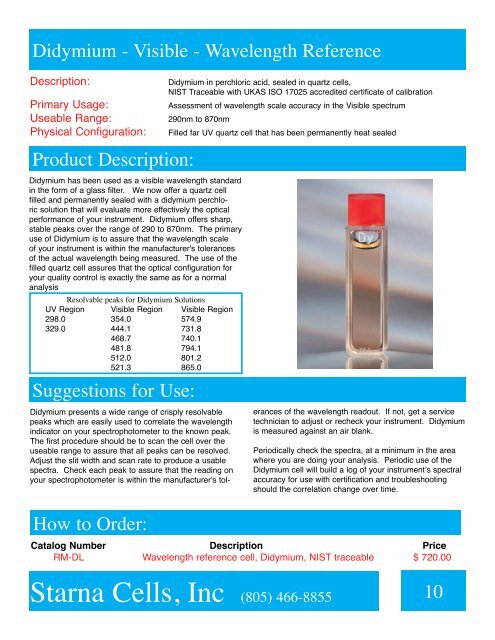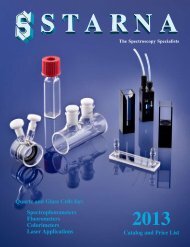Reference Sets NIST Traceable UV/Vis/NIR ISO ... - Starna Cells
Reference Sets NIST Traceable UV/Vis/NIR ISO ... - Starna Cells
Reference Sets NIST Traceable UV/Vis/NIR ISO ... - Starna Cells
Create successful ePaper yourself
Turn your PDF publications into a flip-book with our unique Google optimized e-Paper software.
Didymium - <strong>Vis</strong>ible - Wavelength <strong>Reference</strong><br />
Description: Didymium in perchloric acid, sealed in quartz cells,<br />
<strong>NIST</strong> <strong>Traceable</strong> with UKAS <strong>ISO</strong> 17025 accredited certificate of calibration<br />
Primary Usage: Assessment of wavelength scale accuracy in the <strong>Vis</strong>ible spectrum<br />
Useable Range: 290nm to 870nm<br />
Physical Configuration: Filled far <strong>UV</strong> quartz cell that has been permanently heat sealed<br />
Product Description:<br />
Didymium has been used as a visible wavelength standard<br />
in the form of a glass filter. We now offer a quartz cell<br />
filled and permanently sealed with a didymium perchloric<br />
solution that will evaluate more effectively the optical<br />
performance of your instrument. Didymium offers sharp,<br />
stable peaks over the range of 290 to 870nm. The primary<br />
use of Didymium is to assure that the wavelength scale<br />
of your instrument is within the manufacturer's tolerances<br />
of the actual wavelength being measured. The use of the<br />
filled quartz cell assures that the optical configuration for<br />
your quality control is exactly the same as for a normal<br />
analysis<br />
Resolvable peaks for Didymium Solutions<br />
<strong>UV</strong> Region <strong>Vis</strong>ible Region <strong>Vis</strong>ible Region<br />
298.0 354.0 574.9<br />
329.0 444.1 731.8<br />
468.7 740.1<br />
481.8 794.1<br />
512.0 801.2<br />
521.3 865.0<br />
Suggestions for Use:<br />
Didymium presents a wide range of crisply resolvable<br />
peaks which are easily used to correlate the wavelength<br />
indicator on your spectrophotometer to the known peak.<br />
The first procedure should be to scan the cell over the<br />
useable range to assure that all peaks can be resolved.<br />
Adjust the slit width and scan rate to produce a usable<br />
spectra. Check each peak to assure that the reading on<br />
your spectrophotometer is within the manufacturer's tol-<br />
How to Order:<br />
<strong>Starna</strong> <strong>Cells</strong>, Inc (805) 466-8855<br />
erances of the wavelength readout. If not, get a service<br />
technician to adjust or recheck your instrument. Didymium<br />
is measured against an air blank.<br />
Periodically check the spectra, at a minimum in the area<br />
where you are doing your analysis. Periodic use of the<br />
Didymium cell will build a log of your instrument’s spectral<br />
accuracy for use with certification and troubleshooting<br />
should the correlation change over time.<br />
Catalog Number Description Price<br />
RM-DL Wavelength reference cell, Didymium, <strong>NIST</strong> traceable $ 720.00<br />
10



